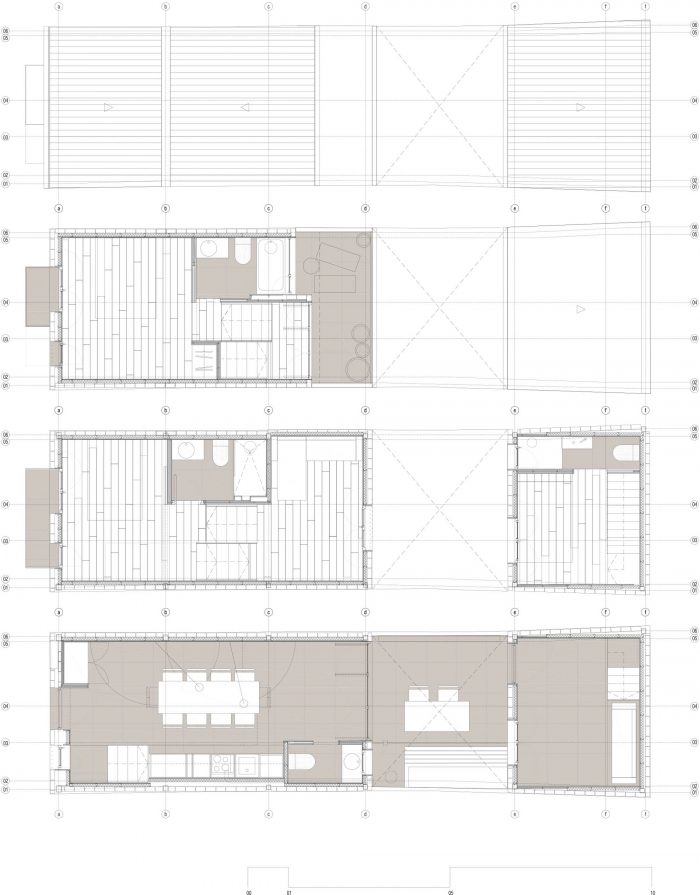卡巴尼亚尔社区与瓦伦西亚市分离,但与之相连。该地区的历史和发展始终与海相连。这种与城市中心的遥远关系,产生了一个新的城市节点,最终通过19世纪以来的连续扩展与主城区连接。
The Cabanyal neighbourhood is separated from the city of Valencia but connected to it. A location with its history and development always linked to the sea. This distant relationship with the urban center, produced a new urban node that would end up connecting with the main city through successive extensions since the 19th century.
Cabanyal的独立产生了它自己非常特殊的结构,来自于实用的类型学和有机的增长:与海平行的细长的街区,在内陆不断增加。最初,第一批建筑是小屋、小木屋和营房,一个接一个地增长,由轻型和简陋的材料制成。资源的缺乏导致了紧凑的长方形房屋,非常狭窄的外墙,最大限度地分配了街道面积。
The independence of the Cabanyal generated its own very particular structure, derived from a practical typology and an organic growth: elongated blocks parallel to the sea that multiplies inland. Originally, the first buildings were huts, cabins and barracks, that grew one after the other, made of light and humble materials. The lack of resources led to compact rectangular houses with very narrow facades distributing the street surface to the maximum.
今天,这个街区保持着自己的特色,有一些流行的、现代主义和当代建筑的例子。尽管有些改造和建筑入侵完全不符合风格和规模,但Cabanyal保留了它的本质,甚至克服了在历史街区开辟一条大路的企图。
Today, the neighbourhood maintains its own character, with sprinkled examples of popular, modernist and contemporary architecture. The Cabanyal its preserving its essence despite some transformations and building incursions totally out of style and scale, and has overcome even the attempt to open a large avenue through the historical plot.
Rosari70项目就在这些地块中的一方墙之间。具体来说,它位于最窄的类型之一,宽4米,深15米。一个面向西-东的地块被三层楼的建筑所包围,形成了一个小巷的感觉。 该项目的难度在于充分利用可建面积,保持所有空间的良好照明,并将连接面降到最低。
Rosari70 project is in one of these plots between party walls. Specifically, is located in one of the narrowest typologies with four meters wide and fifteen deep. A west-east facing plot surrounded by three-storey buildings that creates an alley perception. The difficulty of the project laid in making the most out of the buildable area, keeping all the spaces well lit and reducing to the minimum the connection surface.
第一个重要的决定是不像通常那样把天井放在地块的后面,而是放在一个中间的位置。这样一来,房子就被分成了两个体量,通过降低高度,使室内空间得到更好的日照。第二个策略是在中间楼层的高度将室内板块从一层连接到下一层,通过节省楼板来简化楼梯的开发。此外,楼梯的设计是为了提供最大可能的光线通道。
The first important decision was not to locate the patio as usual, at the back of the plot, but in an intermediate position. This way, the house is divided into two volumes, which allow better insolation of the interior spaces by reducing their heights. The second strategy was to relate the interior slabs at a middle floor height from one storey to the following, simplifying the development of the staircase by saving landings. In addition, the stair design was conceived to provide the greatest possible passage of light.
这些决定,加上底层的巨大高度和避免横向封闭,导致了一个连续、明亮和流动的空间,与人们期望的黑暗和线性的内部空间相去甚远。地块正面的减少,以及板块的移动,导致了与金属结构的合作。通过在大多数空间和元素中展示它,这一点得到了加强。此外,它还与更传统的材料如陶瓷或木材相结合。这些材料更接近于军营的建筑传统,与房屋的结构协同共存。
These decisions, together with the great height of the ground floor and the avoidance of transversal enclosures, result in a continuous, bright and fluid space that is far from the dark and linear interiors that one would expect. The reduced front of the plot, as well as the movement of the slabs, led to working with a metal structure. This was enhanced by showing it in most spaces and elements. Also, it was combined with more traditional materials such as ceramics or wood. These materials are closer to the construction tradition of the barracks that coexist in synergy with the structure of the house.
外墙由一个简单而清晰的结构所统治,遵循邻里的传统方案及其材料,将它们带到一个干净的水平,使其具有现代的特征。外墙的巨大缝隙说明了与邻里之间的关系,但房子将其生活安排在内部。天井使用了内部和外部的语言,两个体量的关系使其具有街道特征。这种特征被露台和阳台上的窗户所强调,这些窗户保持了与外墙相同的语言。露台利用了二楼阳光最充足的地方,把它变成了一个日光浴室。
The facade is ruled by a simple and clear structure, following the traditional scheme of the neighbourhood and its materials, taking them to a level of cleanliness that gives it a contemporary character. The large gaps in the facade speak of the relationship with the neighbourhood, but the house organizes its life towards the interior. The patio plays with an interior-exterior language and the relationship of the two volumes imbues it with a street character. This character is accentuated by the terrace and the balcony windows that maintain the same language as the façade. The terrace takes advantage of the sunniest area on the second floor, turning it into a solarium.
这种天井作为私人街道的感觉被景观设计项目所强调,该项目将长椅和连续的花盆与繁茂的植物(Strelitzias)和装有小果树(金橘)的陶土盆结合起来。景观设计的高潮是一个 “垂直花园”,在天井最阴暗的地方镶嵌着绿色植物。方向、分布和植被将天井变成了一个伟大的热力健康空间。这种真空的工作方式就像一个热引擎。它在一天的早些时候接受阳光(通过减少其通过露台的紧密度),并在其余时间保持凉爽。它还促进了房屋主体的通风,能够通过主立面向西关闭。
This sense of patio as a private street is accentuated by the landscaping project that combines benches and continuous planters with exuberant plants (Strelitzias) and terracotta pots with small fruit trees (kumquats). The landscaping culminates in a “vertical garden” as a mosaic of greenery in the shadiest area of the patio. The orientation, distribution and vegetation turn the patio into a great thermal well-being space. This vacuum works like a heat engine. It receives sun (by reducing its tight through the terrace) in the early hours of the day and stays cool the rest of the time. It also facilitates the ventilation of the main body of the house with the ability to close to the west through the main facade.
建筑师:Manuel Sánchez Hernández
面积:117 m²
年份:2020年
照片:Milena Villalba
首席建筑师:Manuel Sánchez Hernández
技术建筑师: Julia Fernández Sorokina
施工管理:Crearqciò
总承包商:Obraxa S.L
城市:València
国家:西班牙
Architects: Manuel Sánchez Hernández
Area: 117 m²
Year: 2020
Photographs: Milena Villalba
Lead Architect: Manuel Sánchez Hernández
Technical Architect:Julia Fernández Sorokina
Construction Management::Crearqciò
General Contractor :Obraxa S.L
City:València
Country:Spain






















